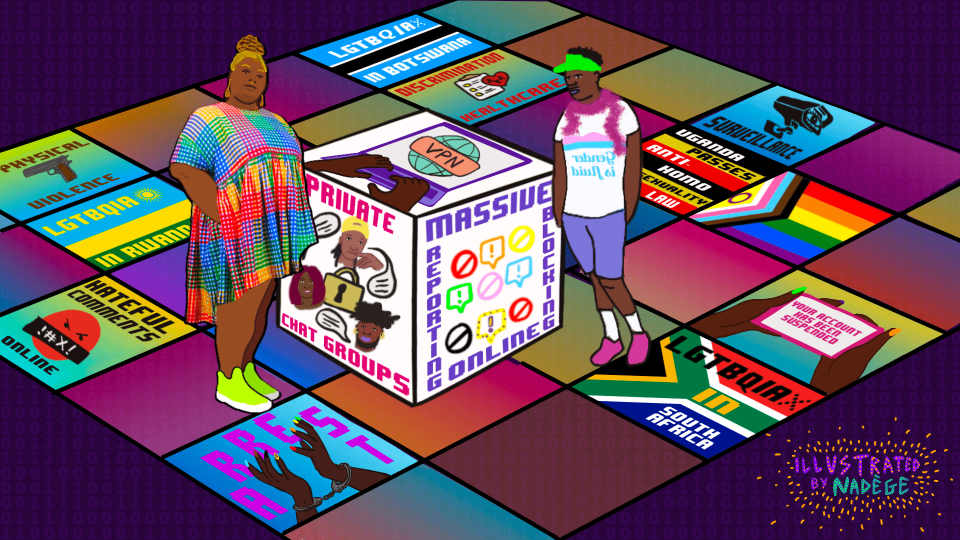
Illustration by Nadege for GenderIT
The Left Out Project explores online gender-based violence (OGBV) as experienced by transgender, non-binary and gender-diverse (TNBGD) people in Botswana, Rwanda, South Africa and Uganda. Through this project, we aimed to centre TNBGD people’s experiences of OGBV so that responses to OGBV (e.g., policies) can be better informed and ensure more robust protections for TNBGD people. The research moves to reconceptualise and reframe OGBV to be inclusive of TNBGD people’s experiences of violence.
Research objectives and rationale
Violence affecting TNBGD people online is widespread across the four countries included in our research. The discourse and realities of online and on the ground for TNBGD people are becoming more hostile. These hostilities seen on social media platforms and dating sites are not solely from cisgender and heterosexual people but also include members of the LGBTQIA+ community. In this research, The Left Out Project took the position that the violence that TNBGD people experience is gender-based violence and should be considered as such and accounted for in current thinking around gender-based violence.
Starting from this position, the objective of the research was to reframe OGBV as current conceptualisations of GBV and also OGBV neglect and invisibilise the experiences of TNBGD people by limiting the definition of GBV to meaning violence against women – specifically, cisgender women.[1] There is some research in the way of GBV as experienced by LGBTQIA+ people, showing that they are “disproportionately victimized by gender-based violence,”[2] but this group is still largely “an understudied population.”[3] As a result of this, an additional objective of this research project was to direct research focus to TNBGD experiences of OGBV and to advocate for future research and policy responses.
Research questions
The primary research questions guiding the project were:
- How do transgender, non-binary and gender-diverse people experience online gender-based violence?
- What kinds of online gender-based violence are transgender, non-binary and gender-diverse people subjected to?
- How do transgender, non-binary and gender-diverse people navigate, manage and remain safe online?
Feminist methods of data collection and analysis
The Left Out Project, in seeking to explore and understand TNBGD people’s experiences of OGBV, adopted a qualitative feminist internet research approach primarily influenced by standpoint theory, intersectionality, reflexivity and feminist ethics of care.[4]
The research was conducted in September and October 2022 with 29 adult individuals 18 years and older who reside in Botswana, Rwanda, South Africa and Uganda. Researchers selected two countries where LGBTQIA+ rights are legalised, namely Botswana and South Africa, and two countries where LGBTQIA+ rights are not protected, these countries being Rwanda and Uganda. The reasoning behind this would be to explore similarities and differences in TNBGD people’s experiences of OGBV and the common themes that emerge across some or all of the countries.
There is some research in the way of GBV as experienced by LGBTQIA+ people, showing that they are “disproportionately victimized by gender-based violence,” but this group is still largely “an understudied population.”
The study makes use of in-depth qualitative interviews, which were conducted online on a one-on-one basis through remote video recording technologies. Connectivity was not always good in all of the countries, and where connectivity failed outright on a first and a second attempt to have an interview, researchers would send the remaining questions to participants via email so that they could respond via text. The data was transcribed verbatim from the audio recorded, and interview recordings and transcripts were stored on our local devices and in a secure shared folder provided by APC.
The research team analysed the data using thematic analysis.[5] Thematic analysis is a qualitative research method for analysing data collected from interviews and focus groups, as well as text-based content.[6] The themes that emerged from the data cut across all country contexts and are presented and discussed collectively and not separated out into country contexts.
Ethical considerations
Incorporating ethics of care into the research allowed researchers to consider the sensitivities surrounding OGBV and the violent experiences participants may have encountered. Using feminist ethics of care, it was possible to create an environment of care that responds to the needs of participants. Researchers contacted LGBTQIA+ activists, organisations, and networks to enlist their help in reaching participants and to ensure that support structures for participants were in place when needed. To facilitate the process of keeping the identities of the participants safe, especially in areas where TNBGD individuals are not protected, researchers opted to use aliases and asked participants to not utilise the video-sharing tool built into the video software and to instead make use of the audio function.[7] Before recording, researchers discussed the research with the participants, as well as any possible risks to them, as a means of ensuring informed consent. Once participants had provided their consent, recording was initiated. The audio file was recorded directly to the researchers' hard drives to avoid copies on third-party servers. As another measure to ensure that the information of participants is kept safe, the research team used Riseup[8] for email communication. Virtual private networks (VPNs) were used to hide the location of the researchers to ensure their safety was also being cared for.
Discussion and findings
TNBGD people participating in this study, shared with us the relentless nature of the violence they experienced, and how they navigated this violence on their social media accounts. Our study found violence directed towards TNBGD people to be consistent with the definition of OGBV. The violence experienced by our participants was found to be in four key forms: dismissal of gender identity; sharing of images without permission; hateful comments; and threats of violence and death.
Participants spoke of the internet and social media platforms as being largely unsafe for TNBGD people, and how when they posted any content online – be it their pronouns, images, thoughts or experiences – they were almost immediately targeted by transphobic individuals. Some participants also expressed concerns over potential government surveillance. These fears are not unfounded, as there have been cases where the police have, for instance, made use of apps to target LGBTQIA+ people.[9] The report highlights how it is necessary for technology companies to consider vulnerable groups when designing and developing applications because, as it currently stands, these groups are usually an afterthought when it comes to matters of privacy and safety.[10]
The violence experienced by our participants was found to be in four key forms: dismissal of gender identity; sharing of images without permission; hateful comments; and threats of violence and death.
TNBGD people also need better reporting mechanisms and responses from platforms which include the specific kinds of violence they experience to ensure their safety which is outlined and a recommendation offered. The consequences of these threats of violence on the mental health of TNBGD people are severe.[11]
Navigating, managing and remaining safe
TNBGD individuals face a disproportionate amount of harassment, discrimination and violence online, and it is important to take steps to mitigate these risks and create a safer online environment.[12] Our participants spoke of using the following strategies to stay safe: blocking; avoidance; and use of closed groups. Some participants spoke of how they manage what information they share about themselves, such as their names and location, to prevent being traced offline – while some abandon platforms altogether to keep themselves safe.
Others opted for closed groups as a way to manage who they were engaging with, TNBGD people are invited to join or must be vetted by others in the group. These groups are spaces for TNBGD where they can find support, advice, resource and community[13] while also largely ensuring the safety of the members of the group.
An interesting and strategic response to the lack of action from platforms to individual reporting that emerged in our study is what we’ve termed a ‘solidarity strategy’, and that is where a group of people all report an account individually in order to gain the platform’s attention. Mass blocking and reporting online refers to the act of blocking and reporting multiple users or pieces of content on an online platform. This is done by marginalised people online for various reasons, such as to protect oneself from harassment and online violence, to report spam or abusive content, or to enforce community guidelines.[14] This is a strategy where one person is not burdened with trying to report content alone, often warranting a response from the platform due to the volume of reporting.
Participants reported that platforms did not take their experiences of violence seriously, we found this to be concerning and reflective of an absence of care on the part of platforms. Some of our participants were not aware of reporting tools on platforms, which is worrying as these tools may protect TNBGD people from OGBV. Reporting tools can help users flag inappropriate content, cyberbullying, and other harmful online behaviours which are associated with OGBV.[15]
An interesting and strategic response to the lack of action from platforms to individual reporting that emerged in our study is what we’ve termed a ‘solidarity strategy’, and that is where a group of people all report an account individually in order to gain the platform’s attention.
Online-offline-online movement
Our report also accounts for the movement of violence from online to offline and back to the online. At the time of this study, there was no available research on the movement of violence from online to offline or offline to online as experienced by TNBGD people. Our report starts the conversation on this, and we hope that further research will explore this area and work towards further protections for TNBGD people and other vulnerable groups.
While someone may be harassed or targeted online, it does not mean that the violence only exists in the digital space; instead, the perpetrator may choose to seek out the person they are victimising and may engage in violence offline, such as stalking and physical and/or sexual assault. Directionality can be difficult to assess for online and offline violence, especially as online and offline interactions become more integrated in people’s day-to-day lives.[16] An understanding of how people move between digital and offline spaces and therefore violence too, needs to be incorporated into current understandings of GBV.
Some of our participants experienced the movement of OGBV from online to the offline, and they shared with us how difficult this experience had been to find themselves faced with the reality of a physical person who wished to harm them. Participants also appeared to be resigned to the idea that violence against them was inevitable. Anticipating violence, while less severe than experiencing that violence, can still lead to significant negative mental health outcomes.[17]
While someone may be harassed or targeted online, it does not mean that the violence only exists in the digital space; instead, the perpetrator may choose to seek out the person they are victimising and may engage in violence offline, such as stalking and physical and/or sexual assault.
Research recommendations and input for policy advocacy
This research evidently shows that the current narrow definitions of GBV and OGBV are deeply harmful and exclude the experiences of TNBGD people. TNBGD people are a key group that requires social, legal and other protective measures, and in order to ensure this, they need to be included in the conceptualising of OGBV and associated responses.
It is urgent that the necessary steps are taken to understand and respond to TNBGD people’s experiences of OGBV. The Left Out Project makes the following recommendations:
Organisations[18] addressing GBV/OGBV can support TNBGD people by:
- Adopting an inclusive understanding of gender, gender identities, gender expression, and OGBV.
- Adopting an intersectional approach that is inclusive of TNBGD identities.
- Offering support services such as counselling, health services and crisis hotlines for TNBGD individuals who are experiencing OGBV.
- Advocating for media representation inclusive of TNBGD individuals to reduce negative stereotypes and promote acceptance and understanding.
- Legally recognising TNBGD identities to pave the way for future laws protecting the well-being and safety of TNBGD people, including in the context of OGBV.
- Including TNBDG sensitisation in school curricula, police training, etc.
Civil society and development organisations can:
- Advocate for policy changes that protect the rights of TNBGD individuals online by seeking to prevent online hate speech and discrimination.
- Raise awareness about the prevalence and impact of OGBV on TNBGD individuals through public campaigns.
- Provide funding for research on online safety for TNBGD individuals.
- Train staff and volunteers on how to recognise and respond to OGBV in an inclusive and respectful manner.
- Provide grants to secure VPNs for LGBTQIA+ community members in countries with discriminatory governments and criminal justice systems.
- Forbid non-consensual sharing of photos, videos and information of TNBDG individuals in organisational policy.
Social media and digital tech platforms must:
- Engage with TNBGD individuals and communities to understand the struggles they face using online platforms and design better, more inclusive platforms.
- Develop clear and comprehensive policies that prohibit online harassment, bullying and hate speech that contribute towards OGBV and ensure that they are enforced consistently and with care.
- Provide inclusive and respectful reporting tools in different languages that allow users to report OGBV.
- Create educational materials about blocking, flagging and reporting perpetrators of OGBV.
- Protect the privacy and personal information of TNBGD individuals.
- Use ethical AI to identify and remove harmful content and prevent the spread of hate speech and harassment of TNBGD persons online.
- Include mechanisms to confirm the identities of users and include “verification” tags in order to safeguard platform users.
- Commit to never sell user data to any third party and to never share data with governments or criminal justice systems.
[1] Jauk, D. (2013). Gender violence revisited: Lessons from violent victimization of transgender identified individuals. Sexualities, 16(7), 808-809.
[2] Williams, C. C., Gibson, M. F., Mooney, E., Forbes, J. R., Curling, D., green, datejie cheko, & Ross, L. E. (2023). A Structural Analysis of Gender-Based Violence and Depression in the Lives of Sexual Minority Women and Trans People. Affilia, 0(0). https://doi.org/10.1177/08861099231155887
[3] Brubaker, S. J. (2021). Embracing and Expanding Feminist Theory: (Re)conceptualizing Gender and Power. Violence Against Women, 27(5), 718. https://doi.org/10.1177/1077801220958494; see also: Bedera, N., & Nordmeyer, K. (2021). An Inherently Masculine Practice: Understanding the Sexual Victimization of Queer Women. Journal of Interpersonal Violence, 36(23–24). https://doi.org/10.1177/0886260519898439; Bograd, M. (1999). Strengthening domestic violence theories: Intersections of race, class, sexual orientation, and gender. Journal of Marital and Family Therapy, 25(3), 275-289; Crenshaw, K. (1991). Op. cit.; Sokoloff, N. (2008). Expanding the intersectional paradigm to better understand domestic violence in immigrant communities. Critical Criminology, 16(4), 229-255.
[4] McLean, N. (2022). Feminist Internet Research Network: Meta-research project report. Association for Progressive Communications. https://www.apc.org/en/node/38022
[5] Guest, G., MacQueen, K.M., & Namey, E.E. (2012). Applied Thematic Analysis. SAGE Publications.
[6] Ponnam, A., & Dawra, J. (2013). Discerning product benefits through visual thematic analysis. Journal of Product & Brand Management, 22(1), 30-39.
[7] McLean, N. (2022). Op. cit.
[9] Van Zyl, I., & McLean, N. (2021). The Ethical Implications of Digital Contact Tracing for LGBTQIA+ Communities. Proceedings of the 1st Virtual Conference on Implications of Information and Digital Technologies for Development.
[10] Nigro, A. (2019, 21 May). Op. cit.
[11] In a 2020 UK report on understanding the nature and the impact of transphobic hate crimes and prejudice, it was reported that “70% of respondents stated that transphobia had an impact on their mental health,” and that “nearly 50% of respondents said they had self-harmed and more than 50% had contemplated self-harm or suicide.” It is critical that we understand the severe consequences of OGBV on mental health and also the risk this poses to the physical well-being of TNBGD people. It is also critical that we undertake similar impact studies for the global South. Bradley, C. (2020). Transphobic Hate Crime Report 2020. Galop. https://galop.org.uk/resource/transphobic-hate-crime-report-2020; see also Jauk, D. (2013). Op. cit.
[12] Noack-Lundberg, K., Liamputtong, P., Marjadi, B., Ussher, J., Perz, J., Schmied, V., Dune, T., & Brook, E. (2020). Sexual violence and safety: The narratives of transwomen in online forums. Culture, Health & Sexuality, 22(6,) 646-659; Haimson, O. L., Buss, J., Weinger, Z., Starks, D. L., Gorrell, D., & Baron, S. B. (2020). Trans time: Safety, privacy, and content warnings on a transgender-specific social media site. Proceedings of the ACM on Human-Computer Interaction 4(CSCW2), 1-27.
[13] Horton, C. (2023). Gender minority stress in education: Protecting trans children’s mental health in UK schools. International Journal of Transgender Health, 24(2), 195-211. https://doi.org/10.1080/26895269.2022.2081645
[14] Contreras, B. (2021, 3 December). ‘I need my girlfriend off TikTok’: How hackers game abuse-reporting systems. Los Angeles Times. https://www.latimes.com/business/technology/story/2021-12-03/inside-tiktoks-mass-reporting-problem .
[15]Gagoshashvili, M., & Kaletsky, K. (2018, 20 June). A double-edged sword: the internet as a tool for trans activism. Access Now. https://www.accessnow.org/a-double-edged-sword-the-internet-as-a-tool-for-trans-activism; Edwards, C. (2022, 2 August). Three tools for journalists to protect themselves against online harassment. Journalism.co.uk. https://www.journalism.co.uk/news/three-tools-for-journalists-to-protect-against-online-harassment/s2/a952257
[16] Lara, L. (2020). Cyber dating abuse: Assessment, prevalence, and relationship with offline violence in young Chileans. Journal of Social and Personal Relationships, 37(5).
[17] Herda, D., & McCarthy, B. (2018). No experience required: Violent crime and anticipated, vicarious, and experienced racial discrimination. Social Science Research, 70.
[18] This includes the criminal justice system, health care system, government structures, and any other groups working in gender, gender-based violence, and online gender-based violence.
- 484 views







Add new comment